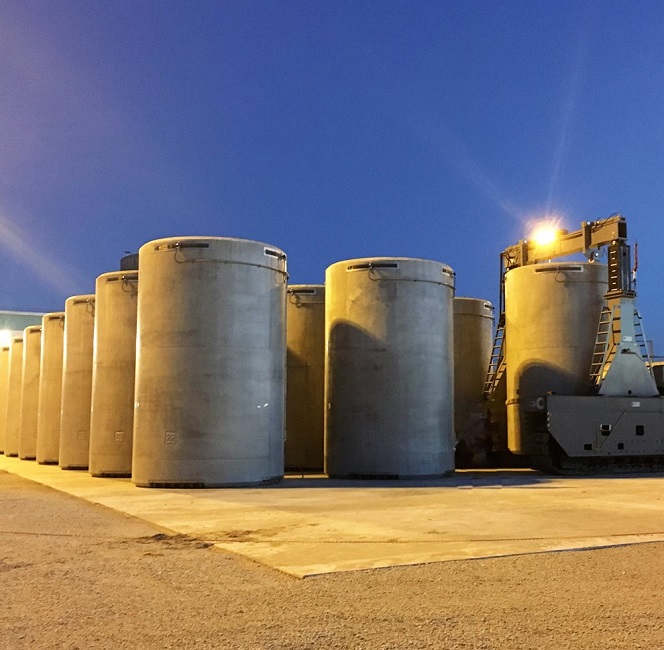Kewaunee uses tech, licensing know-how to achieve fastest reactor defuel
Contractor NAC International used advanced fuel storage technology, licence amendments and a strong partnership with Kewaunee plant operator Dominion Energy to set a record-low time for pool-to-pad fuel transfer.

Related Articles
On June 15, NAC completed the transfer of 887 fuel assemblies from pool to pad in 23 weeks at the 556 MW PWR Kewaunee Power Station (KPS) in Wisconsin.
Kewaunee was shut down on May 7, 2013 after the plant became uneconomical due to falling wholesale prices. In December of that year, NAC was awarded the turnkey contract for site engineering, Independent Spent Fuel Storage Installation (ISFSI) expansion, storage system, pool-to-pad equipment and loading services.
Operator Dominion Energy set a strict six-month defueling schedule in order to achieve accelerated transition to Phase 3 SAFSTOR decommissioning status. Under SAFSTOR, Dominion has 60 years to complete all dismantling and decontamination (D&D) activities.
After completing the spent fuel transfer, NAC announced it had achieved an average fuel unloading time of 3.2 days per cask, far exceeding the initial schedule of one cask per week. On some decommissioning projects, pool-to-pad fuel unloading can take up to 2 weeks.
The project uses NAC’s “ultra-high capacity” Modular, Advanced Generation, Nuclear All-purpose Storage (MAGNASTOR) System. The fuel transfer was accelerated by a Nuclear Regulatory Commission (NRC) license for the MAGNASTOR system which permits the unloading of fuel with minimum 2.5-year cooling times in selected locations, NAC said. Spent fuel is typically cooled for at least 5 years in the pool before being transferred to casks, according to the NRC.
NRC approved an amendment to the MAGNASTOR Certificate of Compliance which shortened the time to place Kewaunee’s fuel into the casks, Prema Chandrathil, NRC spokeswoman, told Nuclear Energy Insider.
Required additional calculations regarding the compatibility with site facilities and the ISFSI met all regulatory requirements, Chandrathil said.
“As long as a company continues to meet NRC regulations as they conduct each transfer an individual company would determine what is or is not the best or most efficient approach,” she said.
The regulatory amendments came at a busy time for the NRC. Between February 2013 and December 2014, the NRC processed more than 70 licensing actions following the early closures of five reactor units: Dominion’s Kewaunee plant, Southern California Edison’s 1.1 GW San Onofre 2 and 3 reactors, Duke Energy’s 842 MW PWR Crystal River Unit 3 and Entergy’s 1.9 GW BWR Vermont Yankee plant.
NRC's significant workload looks set to continue as stubbornly-low wholesale prices have led to further plant closure announcements in the last few years.
US planned nuclear plant shutdowns

Strong package
The MAGNASTOR system incorporates a new approach to water removal and canister drying that shortens operation times, as well as a simple transfer system that facilitates transfer without excessive dose or handling. The cell basket design provides high strength and heat removal of up to 35.5 kW.
A total of 24 MAGNASTOR systems and 14 legacy Areva NUHOMS systems are now stored on the Kewaunee ISFSI, representing the complete spent fuel inventory from almost 40 years of operations.
Kewaunee plant 23-week spent fuel unload campaign:
• 24 MAGNASTOR casks loaded
• 23 casks each contained 37 fuel assemblies; 1 cask contained 36
• 887 fuel assemblies transferred from the pool into dry storage
• Pool-to-pad transfer completed in 23 weeks (five-day work weeks)
• Industry best loading durations that averaged 3.2 days per cask system
• Spent fuel with cool times as low as 2.5 years loaded on an accelerated schedule
Between 2009 and 2014:
• 14 Areva NUHOMS transfer system canisters were loaded onto ISFSI Pad 1
• 448 fuel assemblies in the 14 canisters
• 32 fuel assemblies in each canister
Stored spent fuel by US state
In addition to the technology, NACs' strong partnership with Dominion helped accelerate the unloading process.
“The successful result at KPS is due in large measure to the unwavering support we received from the Kewaunee site personnel who maintained an environment of professionalism and teamwork from the start,” Kent Cole, NAC President and CEO, said in a statement.
The work was completed in the wake of significant staff restructuring. The number of staff employed at the Kewaunee plant has fallen from 635 employees during operations to 140 employees currently. A further 90 staff will end employment over the next nine months after the company completes all remaining activities to place the plant in long-term storage.
Staff strategies
Operators have been urged to plan ahead and prepare plant employees for redeployment in the transition phase after closure, in order to minimize costs. Staffing costs account for around 43.5% of total decommissioning costs and this portion does not include the labor workforce performing the dismantling, the Electric Power Research Institute (EPRI) said in a recent report.
Dominion Energy is among a number of operators who have applied proactive staff planning and communication approaches, Richard Reid, Technical Executive EPRI Decommissioning Technology Program, told Nuclear Energy Insider in June.
"The feedback has been quite positive…it is reasonable to assume this played into the success in the transition process at Kewaunee," he said.
Nuclear operators must provide staff with regular updates on labor milestones early in the planning stages, Joseph Lynch, Senior Government Affairs Manager Decommissioning at Entergy, told Nuclear Energy Insider.
“Everybody’s situation is different; some people are very late in their career and are trying to get to retirement and other people are young and are looking for a future. At the same time, we need to maintain this very skilled and dedicated staff, so we need to make sure that they realize they’re the most important part of this whole process,” he said.
Dominion Energy redeployed Kewaunee plant staff based on their skills, licenses and qualifications, Richard Zuercher, a spokesman for Dominion Energy, said.
“The staffing reductions following completion of the NAC fuel offloading campaign will reduce the number of employees to 50 to safely monitor what’s left of the station,” he said.
By Karen Thomas

